Inside Yale's Vinyl Dungeon
In Fall semester 2025, I’m on a research visit at Yale visiting the Quantum Systems Lab working on error correction techniques for quantum computers. A new university brings with it new adventures, and I wanted to share this one which I’d bet many Yale students probably don’t know about.
How I Found Myself Here
My vinyl story begins back in high school when my good friend Wayne got a Victrola turntable for his birthday. Luckily, Wayne and I had pretty much the same music taste (classic 80s metal – Iron Maiden, Judas Priest, Metallica, etc.), so from then on the default birthday/Christmas gift was always a record. Since we left for college though, I can count on one hand the number of times I’ve gotten to listen to albums on his Victrola.
The story picks up a couple years later when my friend Aaditya at Stanford gifted me a vinyl of Fear of the Dark by Iron Maiden for my birthday. Aaditya just thought the album jacket looked cool and could be a nice piece of wall art, which it definitely is:
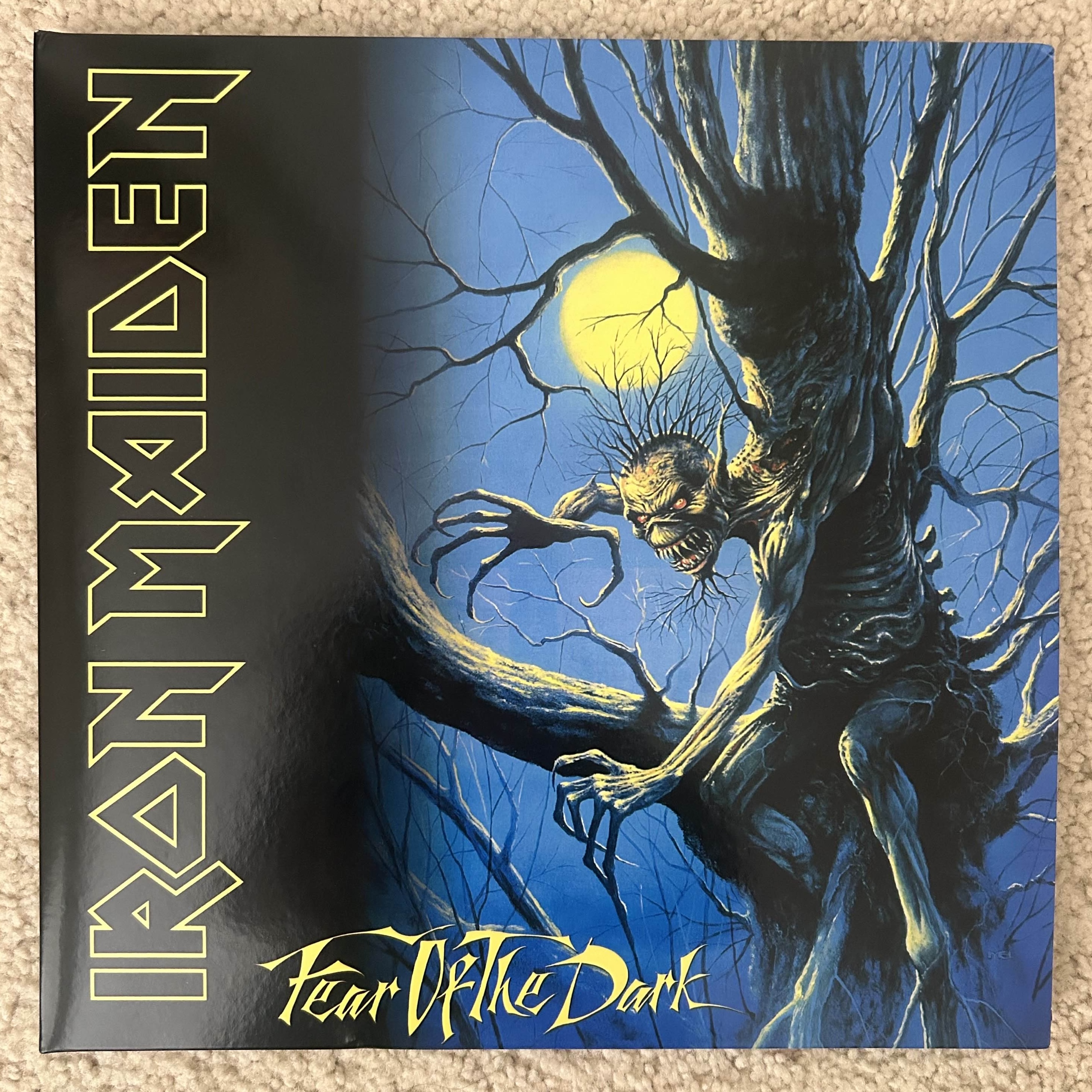
But using one of my favorite albums just as decor seemed like a shame – I had to figure out a way to listen to it. I took a trip to the music library at Stanford and asked the reference desk if they had a record player, and lo and behold, they pointed me to the next room over where they had a turntable with a pair of headphones.
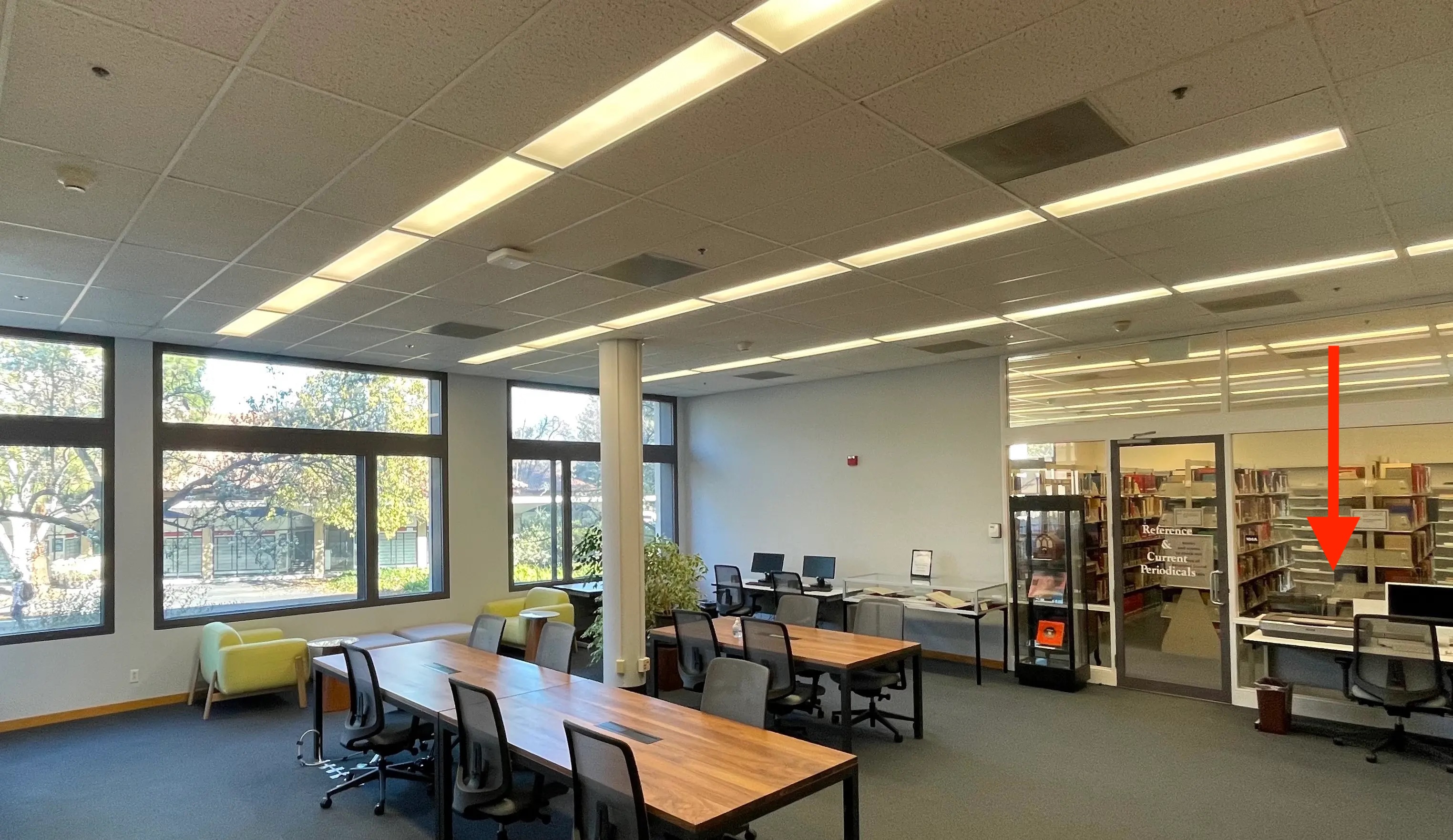
I returned the next day. I put on the headphones, put the record on the turntable, and placed the needle on. I first heard the static and excitedly awaited the experience to listen to this album. It was amazing – after listening almost exclusively to MP3s for the past couple of years, I had forgotten the difference in sound quality.
However, just after Be Quick or Be Dead (the first song on the album), I got a tap on my shoulder. The librarian told me that I had the volume up too high and the people in the otherwise quiet library could hear my Iron Maiden album loud and clear. After this, I decided to sit and listen more stoically; headbanging in a library on a Tuesday afternoon perhaps wasn’t the best idea. Alas, I left with a taste but not the full vinyl experience, as heavy metal is not meant to be listened to on 10% volume.
The story picks back up at my place in New Haven, CT on Sunday, September 28th when I noticed my housemate had a record player. I flipped through his record collection but couldn’t find anything I was too excited about. Then, the idea popped into my head – why don’t I take a look and see if the Yale music library has any records I could borrow? I opened up the catalog and the first record I searched up was Dark Side of the Moon - Pink Floyd, which they had!1
I placed my request and was instructed to wait a couple of business days. I hadn’t heard anything by Wednesday afternoon, so I decided to pop into the Gilmore music library and ask if I had placed the request correctly. The student at the reference desk couldn’t even find my request in her system, and they called in their supervisor. When I showed them my phone, that’s when they realized – Dark Side of the Moon is classified as a “historical record,” so it was handled by a completely different department.
They walked me over to the Manuscripts and Archives reading room, the place you’d go if you were trying to read Yale’s Gutenberg bible (yes, they have one!). Looks like I won’t be able to take this record home… The librarian here referred me to make an appointment to listen to the record with Mark, the head of Historical Sound Recordings, who was back at the Gilmore music library. So, back I went, just to find that Mark wasn’t in the office and I took down his email instead. After that whole rigamarole, I made an appointment with Mark over email for Monday at 3pm, and they placed the request for the record on my behalf.2
Dark Side of the Moon - Pink Floyd (10/6/25)
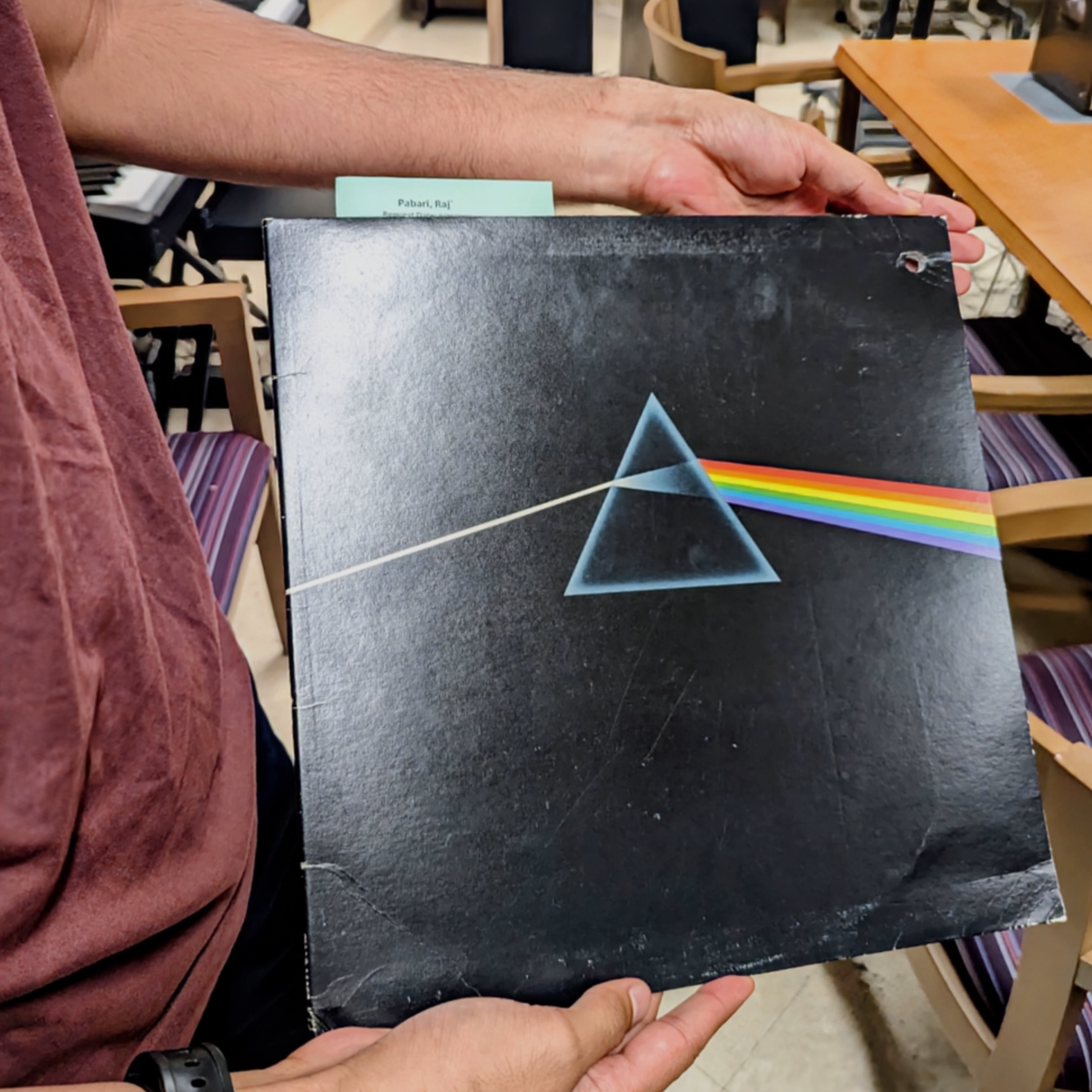
Pre-Listening
Dark Side of the Moon is probably my favorite album of all time (though perhaps this will change over the course of the semester!). On my first listen many years ago, the cacophonous sounds (the ringing clocks of “Time”, the clinking of the cash registers of Money, everything coming together in “Brain Damage/Eclipse”) jarred me and had me reflecting for days about the banal reality we live in. On subsequent listens I paid closer attention to the lyrics, and understood more deeply that the words are trying to represent the trials of life. The lyrics talk about that which separates us – greed, tribalism (“Us and Them”), jealousy. The beautiful part about this album, though, is that you can feel it through the music.
I make my way back to the Gilmore music library and the front desk instructs me to head down into the basement and make a right. Descending into the basement really gives me the dungeon-y feel. I find Mark sitting alone in a big room with sound insulating walls. Prominently featured in this room are a handful of broken records, a plethora of music players, and some huge speakers. I know this is going to be good.
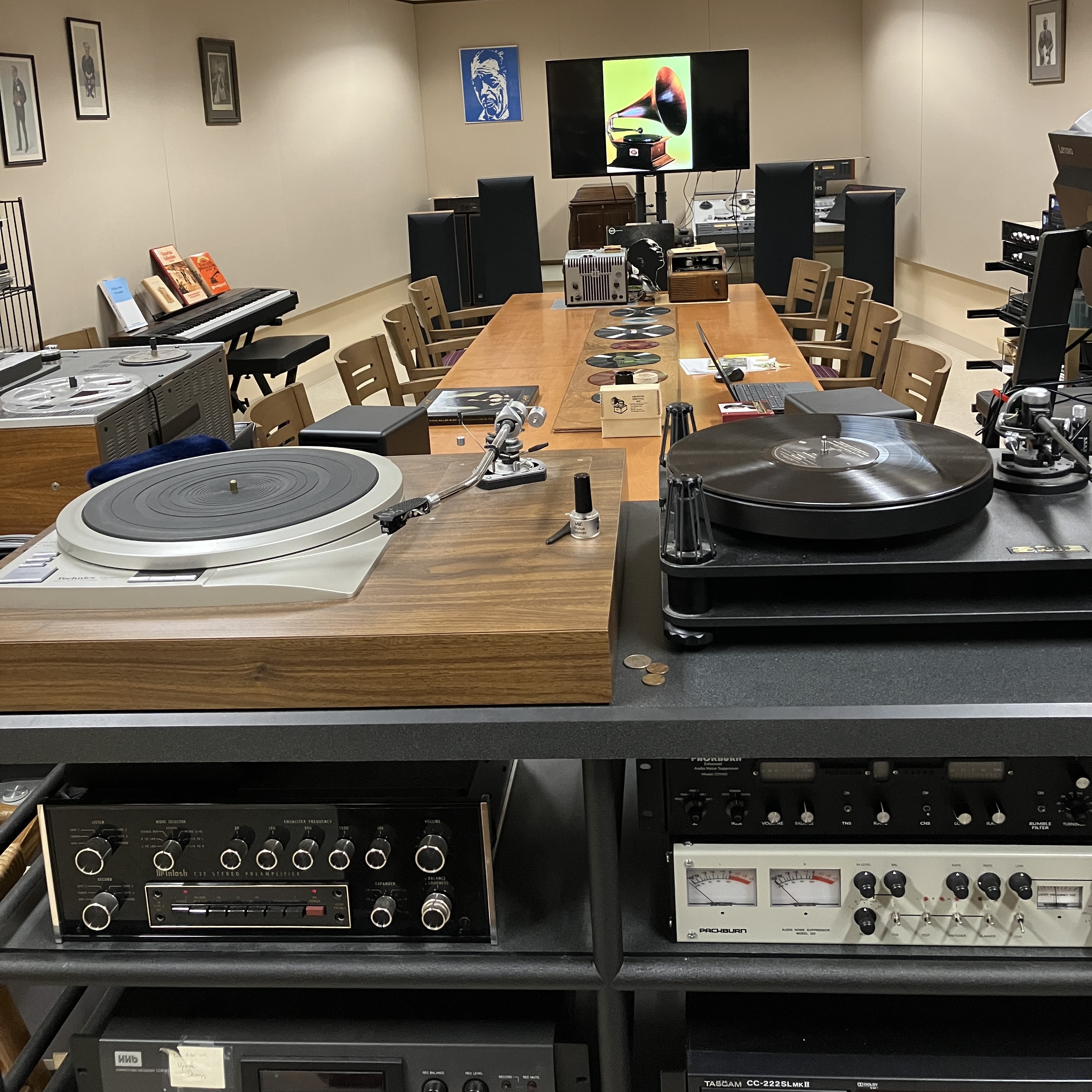
Mark offers me the album cover to take a look at and I notice that on the back the copyright is from 1973. He informs me that we’re about to listen to an original pressing from the first releases of the album. I then ask Mark if it was okay that I didn’t have an academic reason for being here, to which he replied, “personal enjoyment is a perfectly legitimate reason to use the collections.” He tells me that the listening sessions are pretty much only used by music students and people taking classes for which it’s required, but the collection is available for any music enjoyer. To be completely clear, I fall into the latter category – just an “average dude” who enjoys classic rock.
Listening
Mark pulls out the dusty record, and puts it on the turntable. He proceeds to carefully brush off the dust and clean the needle to preserve the record. He says the records are cleaned every time they’re played, but nobody has listened to this one in the 14 years that he’s been the head of Historical Sound Recordings at Yale.
The sound system was absolutely amazing. There are four speakers and I was able to individually resolve every overlapping instrument while also hearing them together. Mark told me afterwards that this sound system is worth about $30,000, and he laments that people these days are just listening to MP3s on their phones instead of investing in their own quality sound systems.
My observations from this listen of Dark Side of the Moon –
- The beating heart throughout the album was absolutely chilling. On vinyl, “silence” is much more staticky than it is on digital, and I felt like the background static makes the heartbeats even more otherworldly.
- The songs really ran together so seamlessly that I had to look them up afterwards in order to reference them in this section. Listening to this album on shuffle would be an absolute crime.
- The rapid drumming in “On the Run” provided an amazing, suspense-building segue after Breathe In the Air that gets cut by the alarm clocks of “Time.” I underappreciated this song in the past and never fully noticed just how fast and crisp the drums are.
- The first side of the record ended at “Great Gig in the Sky” (before “Money”). This was a great place to have “pure silence” as it gives you a moment to sit and bask in the amazing vocals of “Great Gig in the Sky”, but not too long, as the shuffling of the coins of “Money” interrupts you. With this sound system, I felt like I could hear every individual coin clinking together, and it sparked a vision of somebody actually doing this with a cash register. “Money” is such a nice, pop-y song that feels like you’re temporarily back to real life after the insanity of “Great Gig in the Sky.”
Sometime around here, I was blankly staring across the table and I noticed Mark had a plain CD on his side of the table. On the CD I noticed the most vivid rainbow pattern from the diffraction grating. It genuinely looked exactly like the album jacket (which was also still sitting on the table) and I could resolve every color from red to purple. At this point I started to reflect on the fact that the back cover of the album connects to the front cover and refocuses the light, like in this photo I found online:
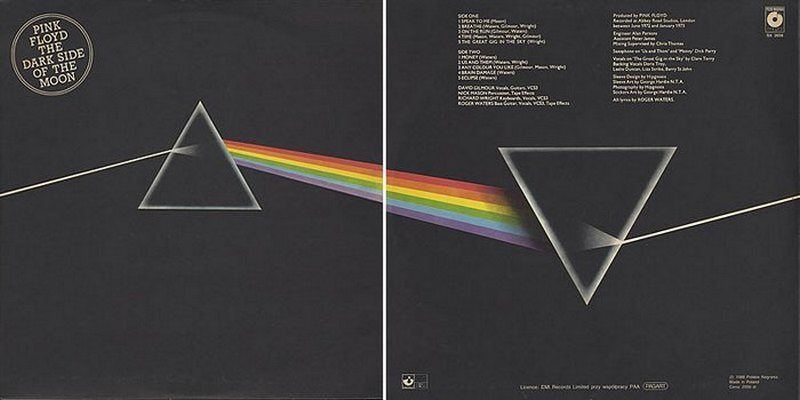
I was staring mesmerised at the mysterious CD and the album cover pondering over all this throughout the second side of the album. If the prism depicts the human things that separate us, the reunification perhaps represents that these human things could be what bring us back together. Despite this distracting me a bit, my musical observations from the second half –
- While the saxophone in “Money” and “Us and Them” is incredible, I was really able to hear the synthesizers behind the saxophone for the first time and appreciate how everything meshes together. Speaking of which, the buildup in Us and Them was absolutely amazing.
- By the time I got to “Brain Damage,” I was already totally tripping out and immersed in Pink Floyd’s world. I could see myself as a lunatic on the grass. Or maybe, the lunatic was in my head all along… I’ll see you on the dark side of the moon.
- The entire album came together beautifully in “Eclipse.” I had never noticed before that the lady from “Great Gig in the Sky” comes back and contributes to the cacophony. The record static and beating heart returns to close out the album, reminding me to deeply breathe in the air once more. By this point, I felt like my heart was beating in sync with the record.
Post-Listening
“So, how do you feel?,” Mark asks.
“Different.”
Mark chuckles and tells me that when he first listened to Dark Side of the Moon, he didn’t talk to anyone for days after. He proceeds to tell me about how the concept album was a new thing in the early 70s, and we started discussing some other famous concept albums - Rumours (Fleetwood Mac), The Wall (Pink Floyd), 2112 (Rush), and next week’s artist.
After leaving the studio, I basically just stared at a wall for half an hour, mesmerised by how music can take you to a different place. I got the inspiration to write about my thoughts, hence this blog post. The feeling stayed with me throughout the evening, the prism from the CD burned into my brain. When I was walking home at about 11pm, the moon was unbelievably full and it was an out of body experience bringing back riffs from the album into my head. Looking back at it now, apparently it was a harvest moon (closest orbit between the moon and Earth), which meant it really was especially bright.
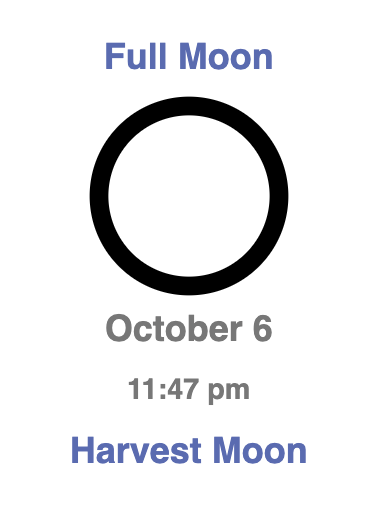
“There is no dark side of the moon… as a matter of fact it’s all dark.” - Pink Floyd (Eclipse)
J50: Evolution of The Joker - Steve Miller Band (10/13/25)
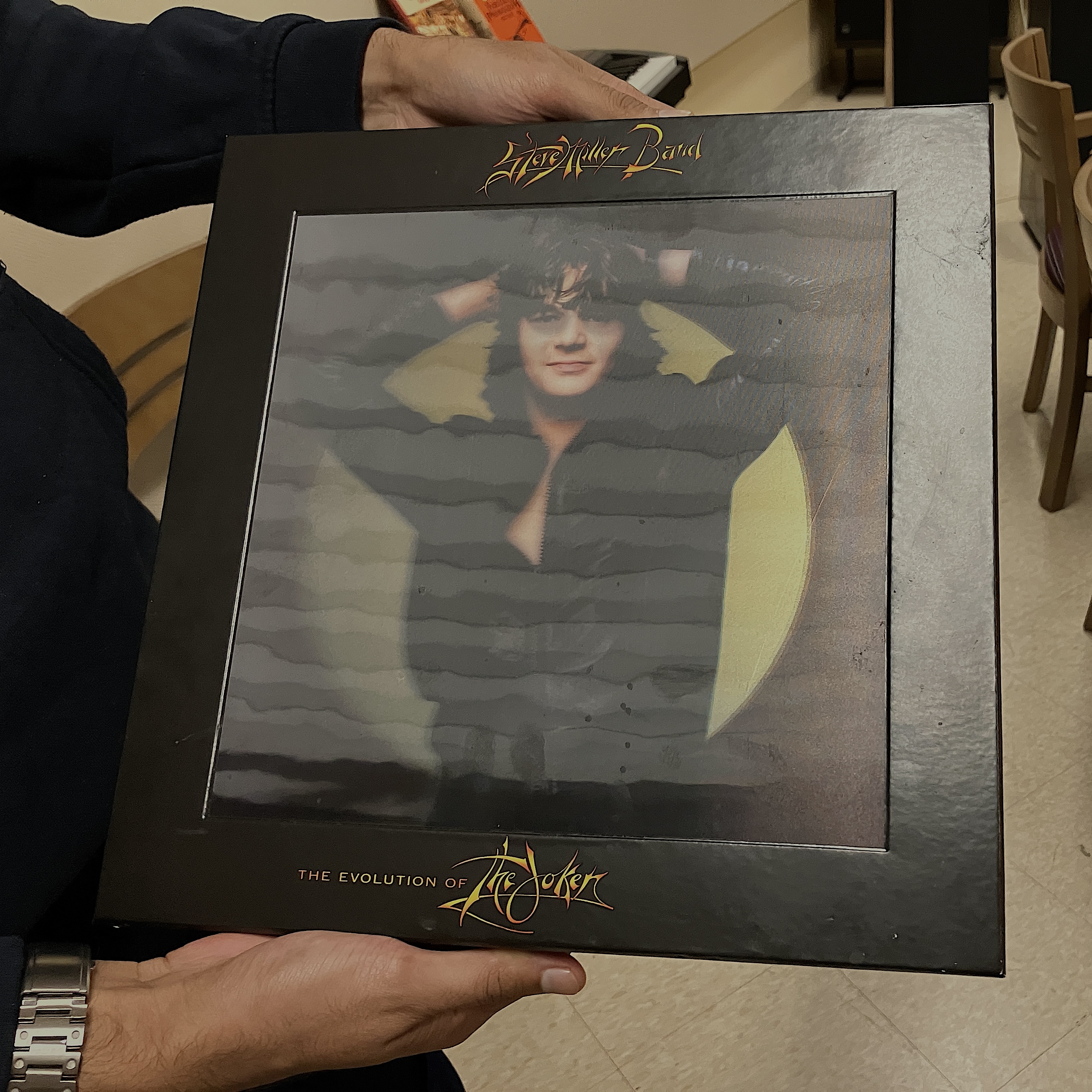
Pre-Listening
As we discussed concept albums last week, Steve Miller Band came up. I mentioned that I love Steve Miller Band but have never heard them on vinyl, to which Mark replied that he is actually friends with Steve Miller! Apparently Steve Miller has helped to support and make use of much of Yale’s blues collection. He recently sent Mark a record which Mark hadn’t had a chance to listen to yet. Mark offered to bring it in so we could listen to it together, which I happily accepted.
I do know Steve Miller Band’s hits – I have their Greatest Hits 1974-1978 album on MP3, and I saw them live on tour at Citi Field last summer (which was so great!).
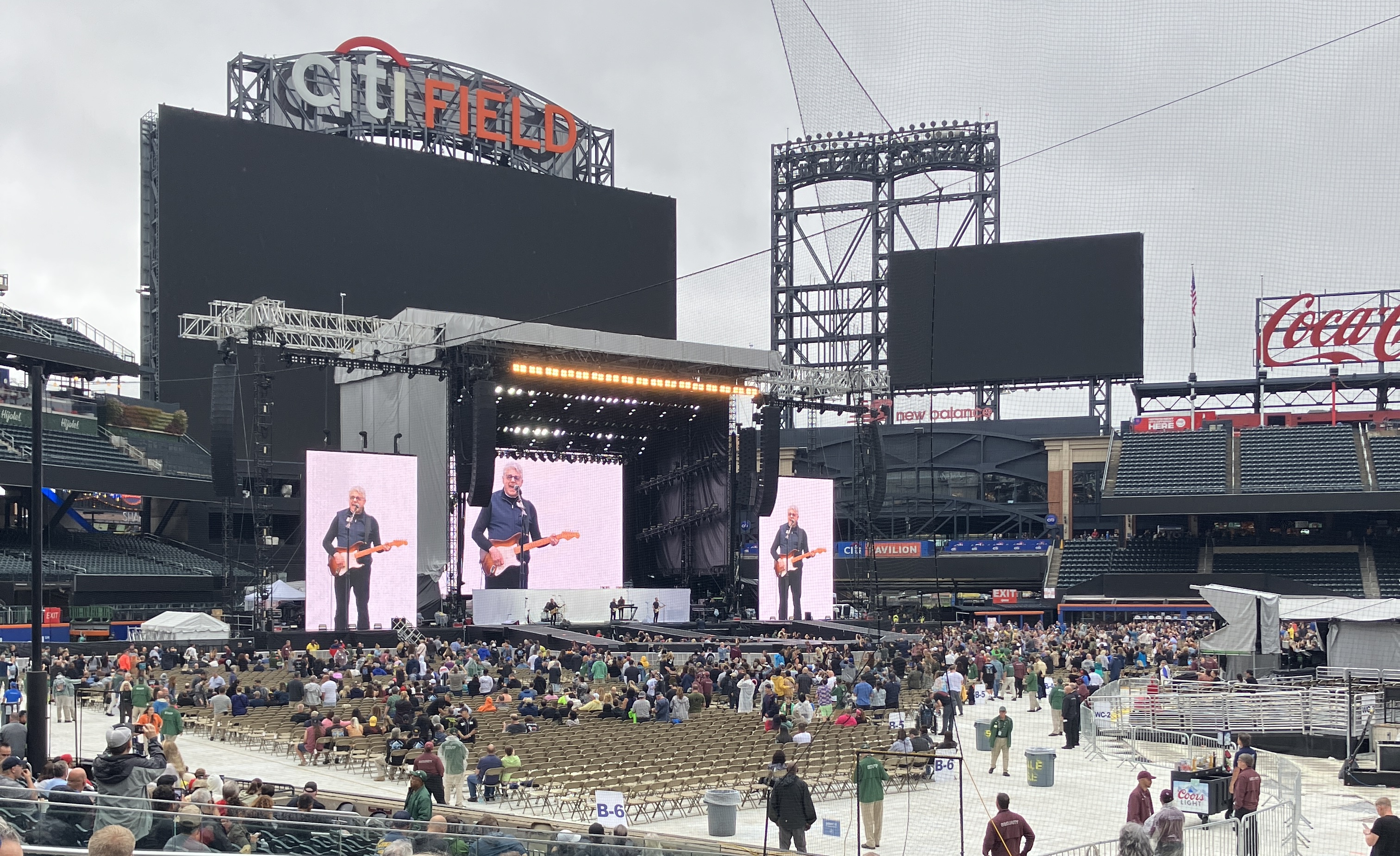
This being said, I don’t know exactly what Steve Miller had gifted to Mark, so I come back to the vinyl dungeon ready for a surprise. I sit down to a copy of The Joker, but it’s one of those images that changes depending on the angle you look at it (TIL this is called “lenticular printing”).
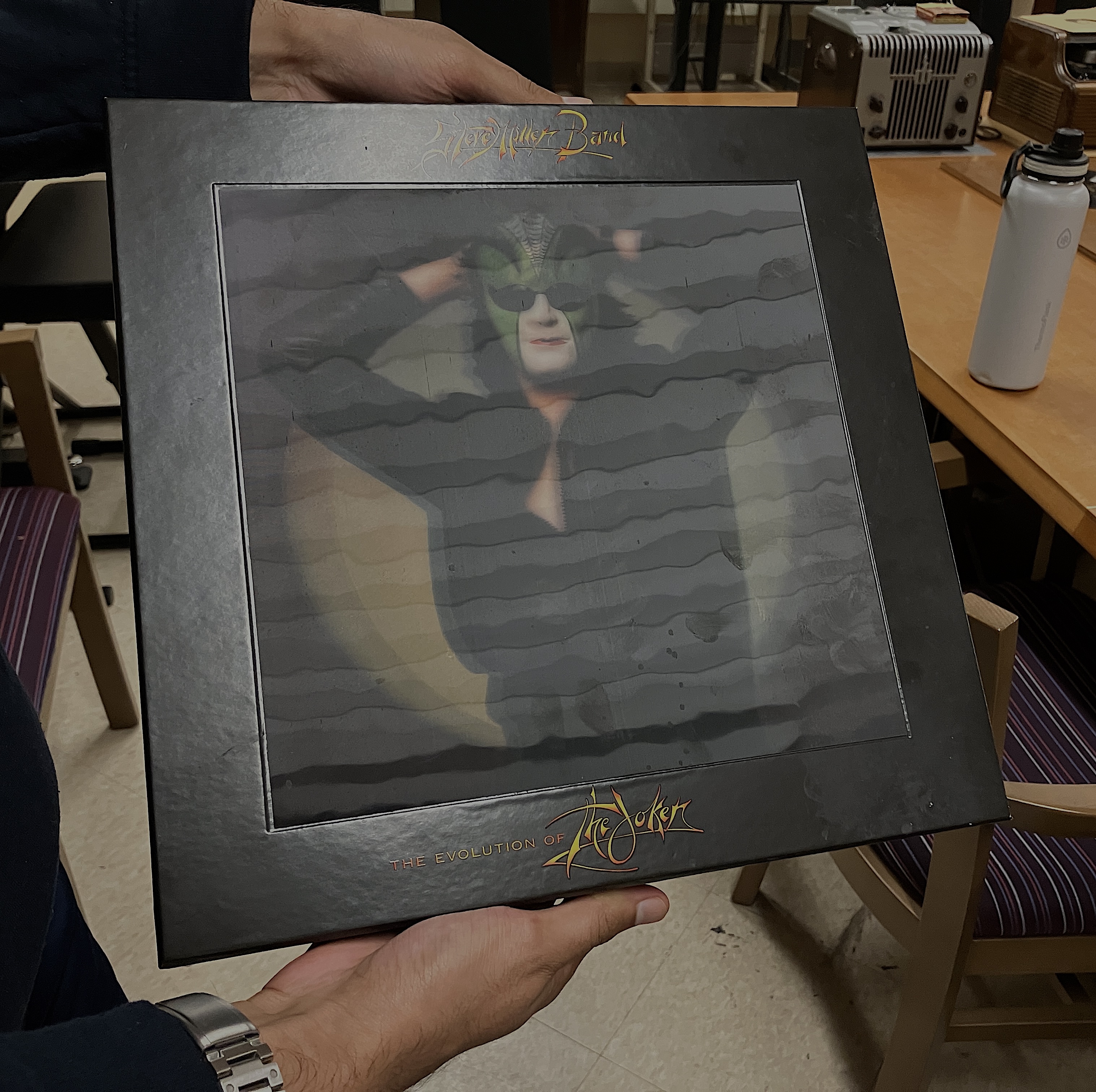
The box set is pretty heavy, so I know this isn’t any old copy of The Joker. I open the box set to find three LPs and a booklet explaining the history of The Joker, inside of which was a “tiny record” that had on it only two songs per side. I had never seen one of these before, so I ask Mark what it is. He told me it’s a 7-inch 45rpm vinyl, which was used for single releases. He pulls out a little yellow adapter that you’d use to play these 7-inch vinyls on your standard record players, since the hole in the middle is too big otherwise.
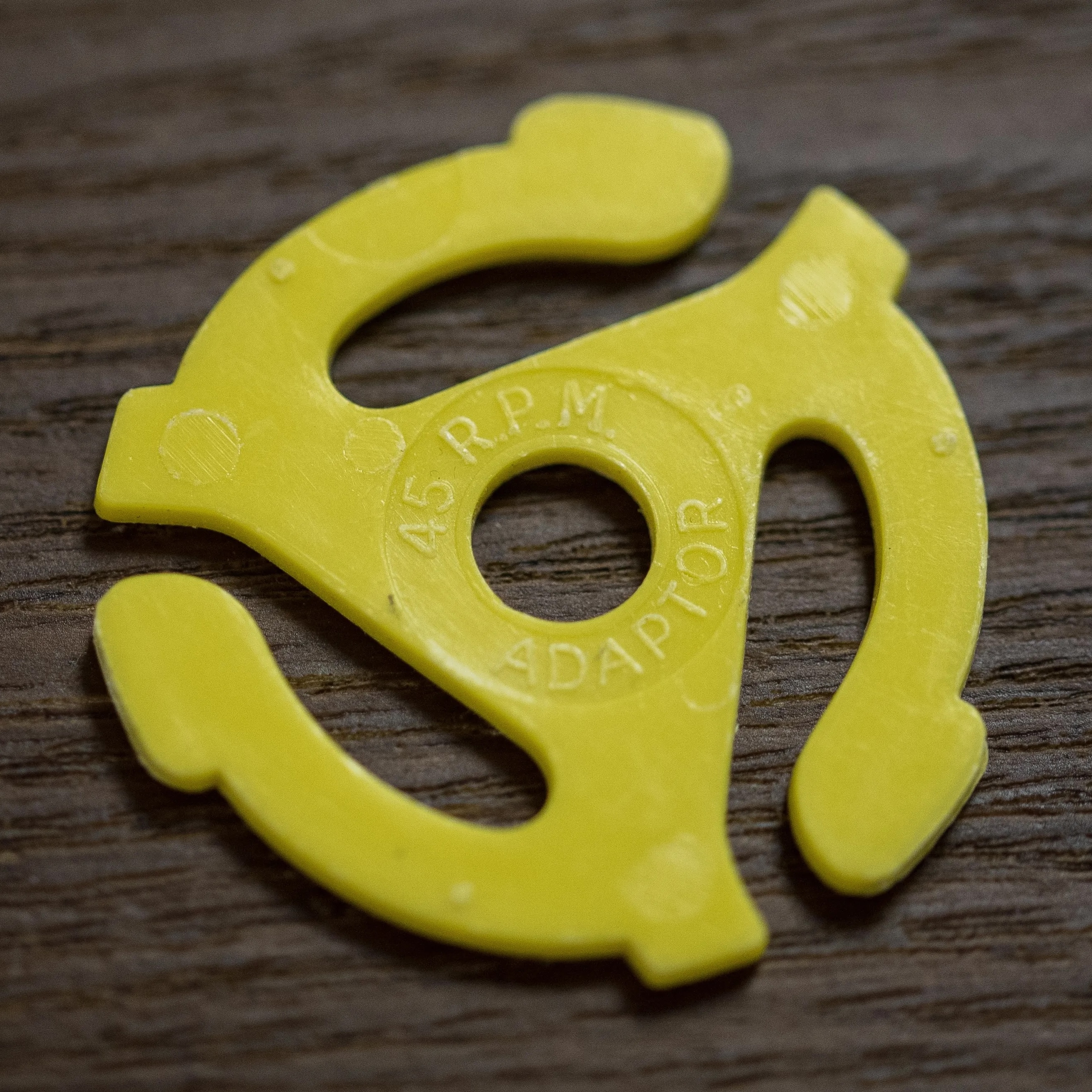
We decided not to play the single and instead listen to one of the LPs. Looking at the tracklist for the three LPs, I’ve barely heard any of the songs (except for “The Joker”). So, I looked back at the booklet, and it turns out this box set contains unreleased and workshopped tracks for each of the tracks on the final Joker album. Pretty exciting, and no wonder I hadn’t heard of any of the songs! I decide to listen to LP 2, since it contains the workshopped versions of the song “The Joker” itself.
Listening
The record opened with Steve Miller giving a preview of the LP. This side is about the creation of the song “Shu Ba Da Du Ma Ma Ma Ma.” It started with a few instrumental songs which served as inspiration, all of which were very drum-centric. I noticed an especially strong cymbal presence in each of these. It sounded like I was listening in on a jam sesh in Steve Miller’s basement or something.
The next track began with a pleasantly surprising harmonica and an acoustic guitar track that sounded nothing like the previous three tracks to me. This being said, I quite liked it! Turns out it was an early tape of “Shu Ba Da Du Ma Ma Ma Ma” from a hotel room. The final track on this side was the album version of “Shu Ba Da Du Ma Ma Ma Ma,” and I could hear the drum bits from the earlier tracks on the album come together with the hotel recording into a fully formed song. Honestly, it was a little tough for me to see how the the earlier tracks inspired the final product, but I’m glad it made sense in Steve Miller’s head because the final product was quite nice. I guess that’s why I’m not a musician and he is 🙂
The second side began with a rehearsal version of “Your Cash Ain’t Nothin’ but Trash,” which I suspect was pretty late in the creative process since it was fairly similar to the album version which followed (though without all the after-effects of course!). Next came a previously unreleased song called “Lidi,” and the first version was a hotel recording which I really loved. This was my favorite track on the LP as it’s simple, raw, and beautiful. I loved seeing Steve Miller’s blues influence in this track. After this came the studio version of “Lidi.”
During the next two tracks we see “Lidi” evolve into a song called “Travelin’,” which Steve Miller mentioned in the commentary helped him find the chorus for “The Joker.” As the title suggests, “Travelin’” is indeed about the life of a free-wheeling traveler, and following it up with the album version of “The Joker” was amusing as the lyrics of “The Joker” have almost nothing to do with traveling. However, there’s still a very clear musical resemblance – the lyrics have a bigger effect on the mood of the song than one might think! In the commentary, Steve Miller mentioned that he didn’t finalize the lyrics until the night before the final recording of “The Joker,” when the perfect words just came to him in a vision.
Post-Listening
Listening to this LP made me reflect on everything that goes into making an album. Before, I thought that artists had it easy, and they’d just record the first thing that comes into their head and hope it lands well. Clearly this isn’t the case! I couldn’t imagine where the inspiration comes from to take the early versions of the songs and transform them into the final versions. “Lidi” and “Travelin’” were both great songs; I’d imagine it’s pretty difficult to have the motivation to keep tinkering around until it becomes “The Joker.” To be a successful artist, you need to know when you can do better than “pretty good” and push for a “great” song, and know that the world is only going to see the finished products rather than all the effort that you put into the LP. Seems like a pretty tall order when you put it that way!
I’m glad I got to listen to this album – it’s definitely not something I would have listened to on my own, but hearing the behind-the-scenes of a hit album gave me a greater appreciation for the process of making music. I’m excited to continue discovering new music with Mark for the rest of the semester!
Abbey Road - Beatles (10/21/25)

Pre-Listening
I love the Beatles and know a lot of their hits. I’ve always thought of the Beatles as having three types of songs – pop (eg. “She Loves You,” “Eight Days a Week,” “Can’t Buy Me Love”), ballads (eg. “Hey Jude,” “Yesterday,” “Blackbird”), and psychedelic (eg. “A Day in the Life,” “Strawberry Fields Forever,” “Lucy in the Sky with Diamonds”). Depending on my mood I’ll listen to these different types of Beatles songs on shuffle, but I’ve never sat down and listened to any of their albums start to finish.
This being said, I did visit Abbey Road when I was in London a couple of months ago. It turns out Abbey Road is a pretty high-traffic street, and this one crosswalk in particular outside of Abbey Road Studios was quite the attraction for some reason.


I was very excited to listen to this album for the first time in the vinyl dungeon and made sure not to listen to any songs off the album the week prior. I was so excited that I talked my office mate Joe into joining me. On Tuesday afternoon, we headed over to the library together and I introduced him to Mark.
Listening
I didn’t read the track listing ahead of time, so I’m ready for a surprise. The album begins with a couple of hits, “Come Together” and “Something.” “Something” is one of my favorite Beatles songs and I really enjoyed hearing it in the dungeon. Next up is “Maxwell’s Silver Hammer,” which was quite jarring after “Something” (a beautiful guitar fade out is cut by “Joan was quizzical…”). The lyrics were no less offputting – it sounds like Maxwell is killing his teacher since she gave him a detention? This song confused me but left me very curious as to what the rest of the album had in store.
The next song was “Oh, Darling,” which I didn’t realize was even a Beatles song. I was pleasantly surprised to hear it after “Maxwell’s Silver Hammer” and this ended up being my favorite track of the album. Throughout the album (and in this song especially) Yale’s sound system allowed me to specifically listen to and appreciate Ringo’s drumming for the first time. The next song was “Octopus’s Garden,” which I also quite liked and focused closely on the drumming. I’ll definitely pay attention to Ringo’s drumming when I listen to Beatles songs next!
Following this was the final song on the first side, “I Want You (She’s So Heavy).” The main thing that I noticed during this song was the repetitiveness of the lyrics – pretty much all they say during this song are “I want you” and “she’s so heavy” (the meaning of the latter I still don’t understand3). Despite this, the song still clearly portrayed a distinct emotion associated with each of the two lyrics, which eventually converge and clash in the instrumental that concludes the song. “I didn’t see that coming,” I say after the abrupt ending of this song, and Mark lets out a small chuckle. Joe told me afterwards that this was his favorite new song he discovered on the album.
Sitting in silence as Mark flips the record, still a little shocked by the abrupt ending of “I Want You (She’s So Heavy),” I was left confused about the first side. It just didn’t make sense to me as a composition. Each song felt like it could have been on its own album. Almost every song sharply “cut” the previous and substantially changed the vibe. Keeping in fashion, before I could think too much, the soft acoustic guitar of “Here Comes the Sun” cuts the silence and changes the vibe once again.
The second side made more sense to me as the songs ran together much more smoothly. “Sun King” is the overlooked cousin of “Here Comes the Sun” which I had never heard of. Once again, this song had me reflecting on the absurdity of the lyrics when they started speaking Italian4. I quite liked “Polythene Pam” and “She Came In Through the Bathroom Window.” I also thought “Golden Slumbers” and “Carry That Weight” were a brilliant couple minutes of music. I loved the second side as a complete piece, though some of the individual songs on the first side were more memorable.
The album ends with a song called “The End,” which I felt wrapped up the album very nicely. However, after an unusually long pause, I was surprised that the silence was cut once again by the cute little song “Her Majesty,” which didn’t feel as satisfying but seemed to fit with the theme of the album.
Post-Listening
After we wrapped up, I shared my thoughts with Mark about the album feeling disjointed. He told me that the album was the Beatles’ last together, and by this time they were already disagreeing a lot artistically. Looking at which songs were written by which Beatle after made a lot of sense; I could see the distinct creative visions of each (no wonder “Octopus’s Garden” felt so different!) and understood why the first side felt disjointed. Apparently “You Never Give Me Your Money” was quite a literal song about the band’s woes, and “Maxwell’s Silver Hammer” caused a lot of internal strife in the band.
Overall, many of the songs in this album didn’t fit into the three types of songs that I had preconceived for the Beatles, and I enjoyed seeing a different side of them. Mark told me that the critics were initially mixed on the album, but eventually warmed up to it. I feel quite the same; I left the vinyl dungeon confused, but reflecting on it I can see the vision and appreciate the artistry and risks taken throughout the album. The Beatles never seemed to play it safe and were always experimenting with new types of music, and I think pushing the envelope with albums like Abbey Road is why they were and continue to be so universally loved.
Born in the USA - Bruce Springsteen (10/28/25)
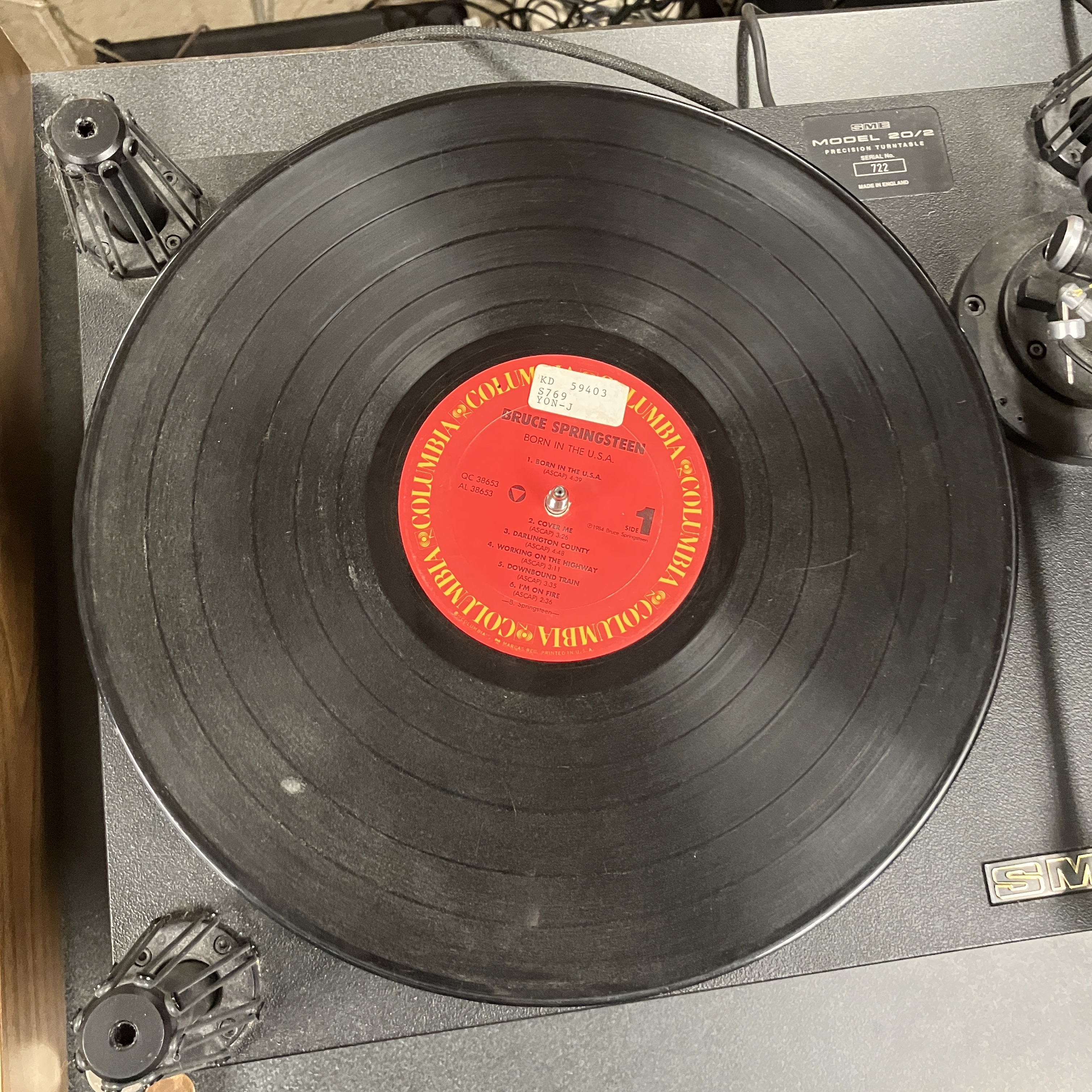
Pre-Listening
My prior knowledge of Bruce Springsteen’s catalog was very limited; I only knew his biggest few hits. I chose to listen to Born in the USA for this exact reason – I’ve been enjoying discovering new music on vinyl, and listening to albums which I’m not familiar with is the best way to do that. So once again, I came in cold and made sure not to listen to any Springsteen in advance to preserve my first listening experience. Joe also liked our session enough last week that he came with me again!
For unknown reasons, this LP was stored without a jacket, and it came out of storage very dusty and with visible scratches. Mark cleaned the record the best he could, but TLC alone couldn’t get rid of the strong staticky background noise. Luckily, this is where the $30k sound system came into play – Mark turned some knobs to suppress the background noise, and voilà, the constant static disappeared. The only downside of the noise suppression was that the drums were also a bit suppressed, so I noticed myself naturally focusing more on the other instruments throughout the album.
Listening
Overall, I felt this album was much more vocally and lyrically focused than any album we had heard before in the dungeon. The tunes felt fairly simple, the songs were fairly formulaic (chorus-verse-chorus structure), and there were almost no drum or guitar solos. This was an especially stark contrast to last week’s album (Abbey Road - Beatles) which featured a significant mix of nonsense lyrics, songs with less than ten unique words, and complex instrumental medleys. The purpose of the album felt like The Boss’s artistic portrayal of the “real” America, and spoiler alert: he didn’t paint too pretty of a picture.
The album begins with “Born in the USA” which is superficially patriotic, but a closer listen finds that it’s about the hardships of a Vietnam War soldier rather than how glorious it is to serve one’s country. It also occurred to me that this album was released almost 10 years after the Vietnam War ended, which I never quite put together since it sounds right at home with the other Vietnam War-era songs I know. I wonder what the sentiment was about the war when this album was released.
“Darlington County” made me second-guess where Springsteen was from, because it had a strong Southern/Midwestern sound but I thought he was from Philadelphia (because of his song “Streets of Philadelphia”). Turns out all these guesses were wrong – he’s originally from New Jersey – but alas this song changed the vibe of the album a bit and made it feel more country. I also loved the saxophone in this song! “Working on the Highway” was a nice continuation and by the end of it I was fully convinced he was from the South.
The final song on the first side was “I’m on Fire,” one of Springsteen’s hits that I had heard beforehand. The song is pretty catchy, but focusing on the lyrics this time around, I was taken aback to say the least. It sounds like the song’s character wants to have an affair with someone who’s already in a relationship, which is a disturbing role to be playing. Hopefully it was just in his imagination… Either way, “I’m on Fire” fades out nicely to end the first side.
The second side picks up the tempo immediately with “No Surrender.” This was a more standard love song, which left me a bit confused after “I’m on Fire” since it’s not clear if this is about the character’s girlfriend/wife or his affair. I quite liked the saxophone solos on “Bobby Jean.” That song was quite somber and painted yet another a bleak picture of reality.
On this listen, I really appreciated the bass line throughout “Glory Days” rather than just focusing on the keyboard in the foreground. The song is fairly poppy, but has quite a sad undertone; it’s all about how the titular “glory days” are behind us.
“Dancing in the Dark” is another classic upbeat Springsteen song which sounded great in the dungeon. For how happy it sounds, listening to the lyrics revealed quite a sad undertone. The subject of the song is living in a self-proclaimed “dump” and wants to change every aspect of himself, but he’s just “sitting around getting older.” We couldn’t escape the record scratches during this song though – the record was skipping and Mark had to help the needle along a couple of times. Now I know what it means to sound like a broken record! Either way, this song came as a pleasant surprise.
The album ends with the ballad “My Hometown” which was my favorite new song on the album. It was really chilling and filled me with emotion to end the album. While the last two songs covered up the somber topics with catchy beats, this song was unambiguously sad. Main Street is becoming a ghost town, factories are shutting down, your friends are leaving and they’re not coming back. This is probably why Bobby Jean was leaving earlier in the album. The final words lay out Springsteen’s closing message very plainly with the words “this is your hometown.” Springsteen’s bleak America isn’t fictional – it’s the real America that you are living in.
Post-Listening
“My Hometown” left me with plenty on my mind as Mark asked Joe and I what we thought about the album. I was still confused and processing the album, but I mentioned that I found it very lyrically focused. Perhaps sensing my confusion, Mark helped give a bit of context for the album. He said that this album was touted by the right (famously in Ronald Reagan’s campaign trail), missing the nuances throughout. I’d say that the album is neither patriotic nor anti-American, but rather tells a compelling story of life in America. The Boss seemed proud to be American but unhappy with what he was seeing around him. The outlook of nearly every song on the album is quite somber.
Mark also mentioned that he went to Springsteen’s Born in the USA tour and it was very memorable. He said they played for about four hours and there were a lot more saxophone, guitar, and drum solos interspersed throughout. During “Dancing in the Dark,” Springsteen even pulled a girl from the audience to come dance with him onstage, just like in the famous music video. Fun fact: in the music video, the girl he brings up is a young Courtney Cox before she was famous. It sounded like a very fun 80s concert!
Mark ended up ordering a new copy of Born in the USA for Yale’s collection, so future listeners can enjoy the album without the noise suppression. He also gave me the copy that we listened to today instead of throwing it away (thanks so much Mark!). Good news: the new record came with a jacket and album cover!
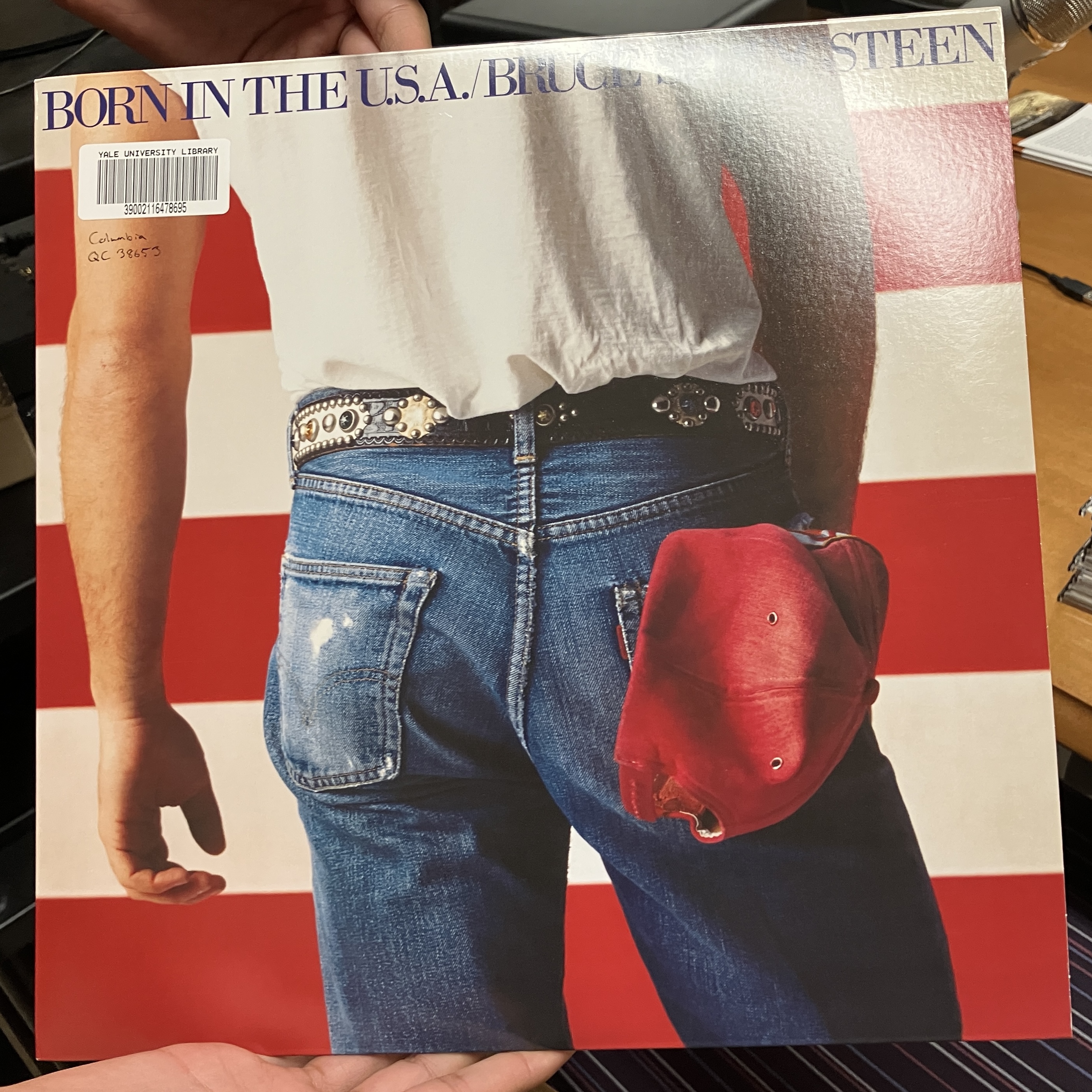
LA Woman - The Doors (11/4/25)
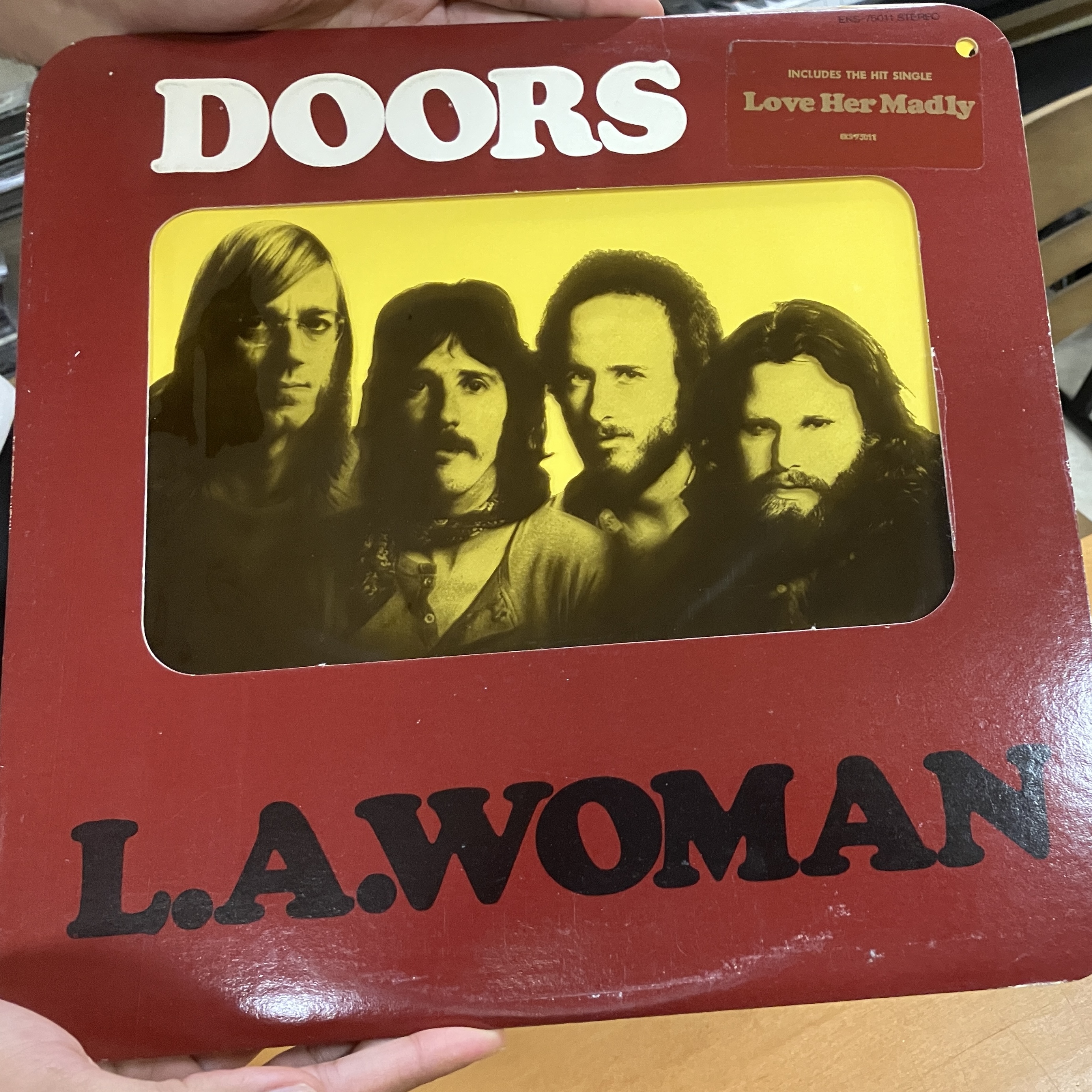
Pre-Listening
My prior knowledge of The Doors was even more limited than Bruce Springsteen, only knowing a few of their hits. I seriously had no idea what to expect; I didn’t even look at the track listing. I did visit Jim Morrison’s grave at the Père Lachaise cemetry in Paris.

The album cover was interesting; the album jacket is solid yellow on one side (the side you typically see through the cover), but on the other side there’s a person on a telephone pole crucifix.
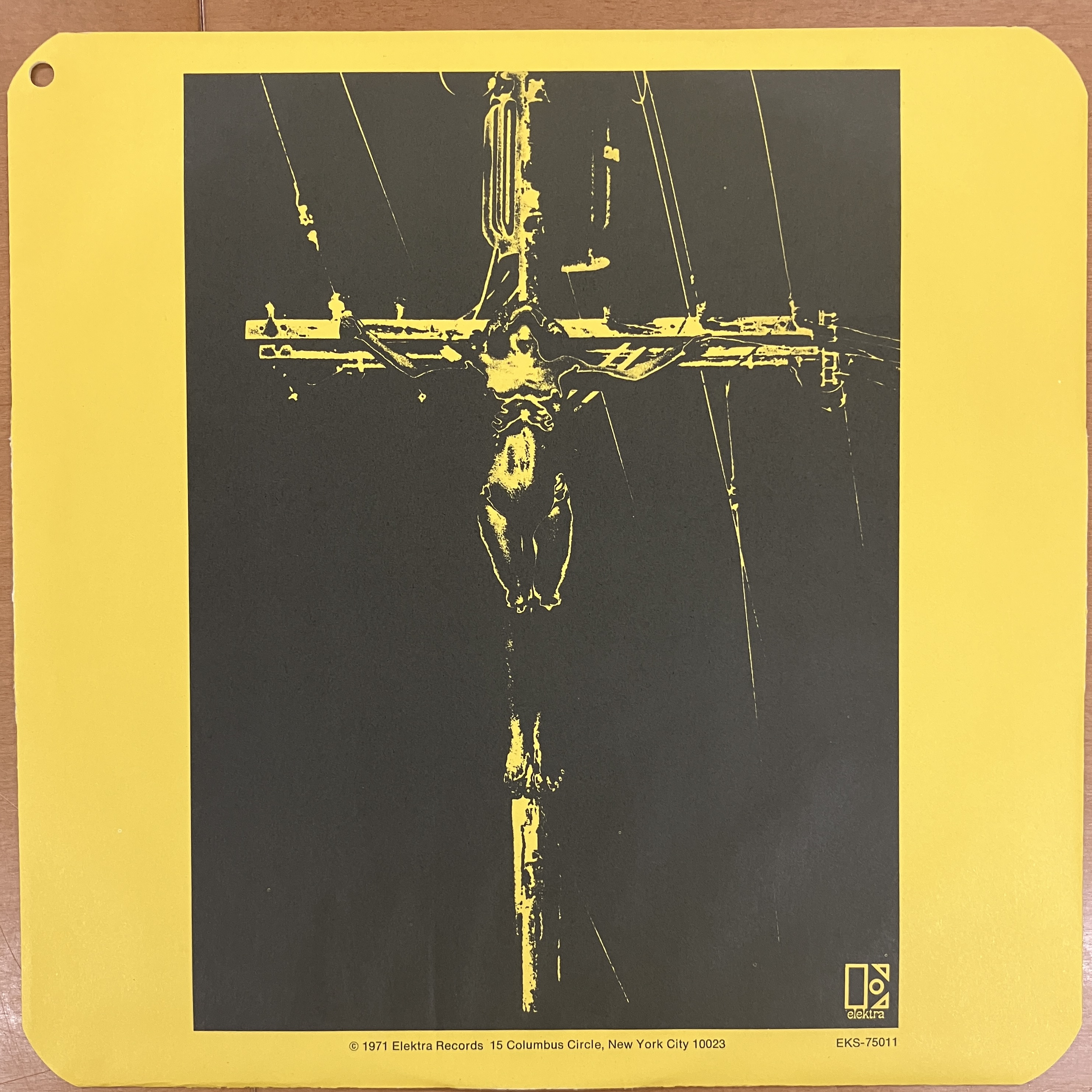
Apparently this jacket is only on the first pressings of the album, so we definitely had an early copy on our hands. It’s not clear who is on the crucifix; I thought it could be Jim Morrison himself, but it could also be the titular LA Woman. The album cover looks a lot different when you flip the inside around!
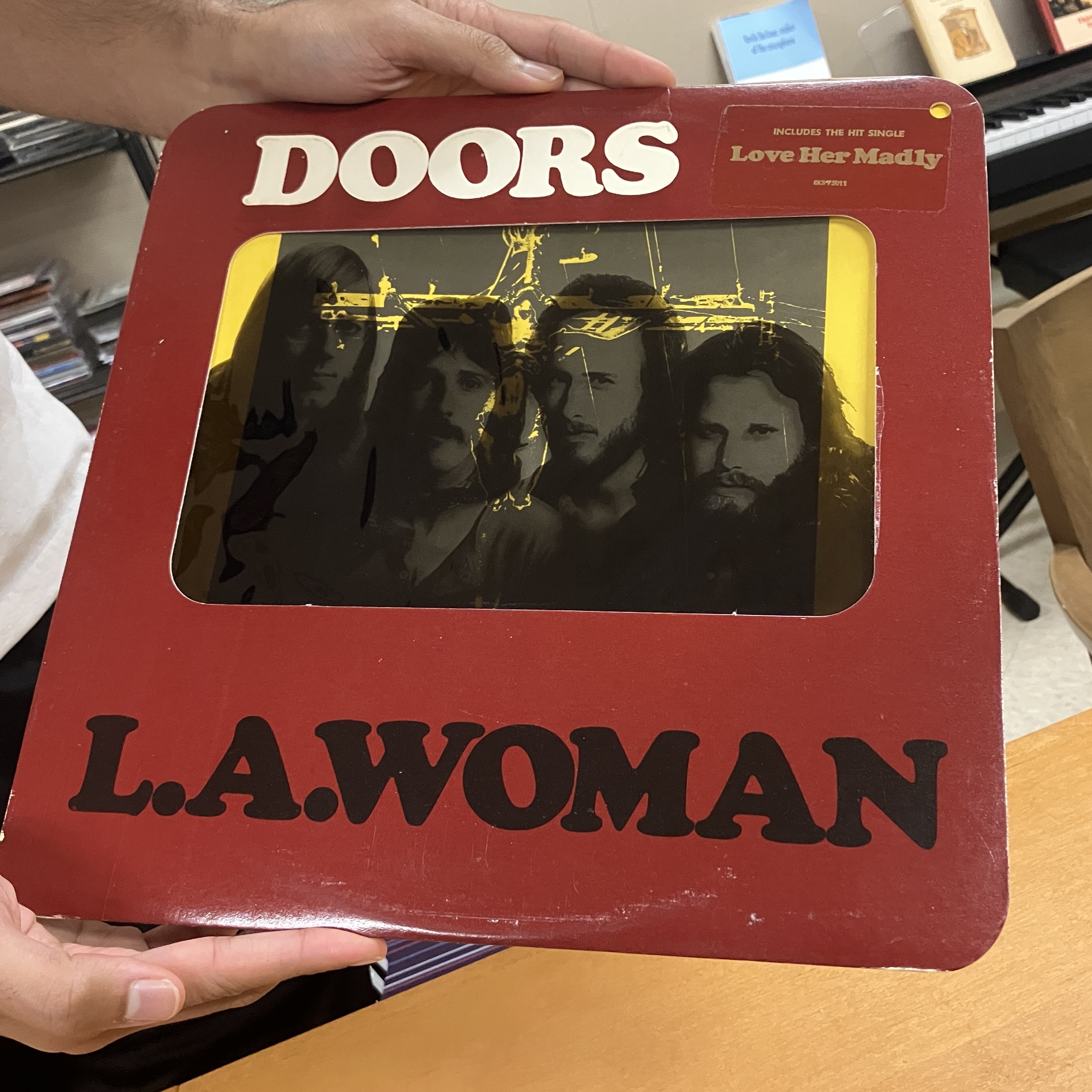
Listening
The fast, punchy beat of “The Changeling” gripped me immediately. I certainly wasn’t expecting the blues-rock fusion that was awaiting me. The style of The Doors was unlike any other I had heard before, and I absolutely loved it.
The medley of instruments throughout the album was also very impressive to me. Initially, I was focusing a lot on the intricate keyboard pieces. Then, I turned my attention to the drums, and noticed that they were using the cymbals almost constantly to keep the beat. The songs had very strong bass guitar lines running through them that were themselves amazing.
All of this is followed up by the ballad “Cars Hiss by my Window,” at the end of which Jim Morrison imitates a guitar with his voice so well that I couldn’t tell until his voice broke. His voice is extremely deep but has such a wide range, unlike any other I could think of. I was pretty convinced that his voice was edited in post-production.
Beautifully emerging out of “Cars Hiss by my Window” was “LA Woman,” which was my favorite song on the album. The keyboard in this song was exceptional. I really appreciated the rhythmical variation in this song (and many others), how it calms down and then re-emerges again with the “Mr. Mojo Risin” (an anagram for Jim Morrison) getting progressively more and more intense. This song ended the side perfectly and left me ready for the next.
“L’America” opened the next side with a riff so uncharacteristically heavy that it sounded straight out of a heavy metal song. It reminded me of the riff in “Black Sabbath” by Black Sabbath. In “Crawling King Snake,” I noticed a parallel with Pink Floyd in the way that they one at a time introduced one guitar line, then a drum line, and then a couple more guitar lines. Within a few bars, you have this whole medley come together with a bunch of overlapping sounds, but you can hear each individually since they were introduced one by one.
“The WASP” was yet another different type of song. It was so lyrical that it sounded like the words were written first and the tune was filled in after. There were portions of the song where Mojo was just speaking, almost as if he was reading a poem. The album ends with “Riders on the Storm,” which I never realized has an actual rainstorm going on throughout. The final few seconds of the album are literally just rain, which was a beautiful way to end as we faded to silence.
Post-Listening
Mark was also very pleasantly surprised by this album, and he mentioned a couple of musical details that were far too sophisticated for me to pick up on:
- He counted 3 songs that had the 12-bar blues structure at their core, which (as the name suggests) is characteristic of blues songs but very uncommon in rock songs. In his words, the structure “strictly follows a predetermined harmonic progression that divides into three phrases of foour mesaures and ends in the same key it started in.”
- He also mentioned that the keyboard solo in the song “Hyacinth House” is actually quoting the theme of Frederic Chopin’s Polonaise.
Mark also mentioned that Jim Morrison was famously arrested on stage in 1967 at the New Haven Arena on counts of inciting a riot, obscenity, and indecency. He was apparently the first rockstar to be arrested during a live performance.
For my part, I read online that part of the reason the sound was so unique was that Jim Morrison recorded some of the vocals in a tiled bathroom. I also learned that this was their last album recorded before Jim Morrison suddenly died (or disappeared?).
Thriller - Michael Jackson (11/13/25)
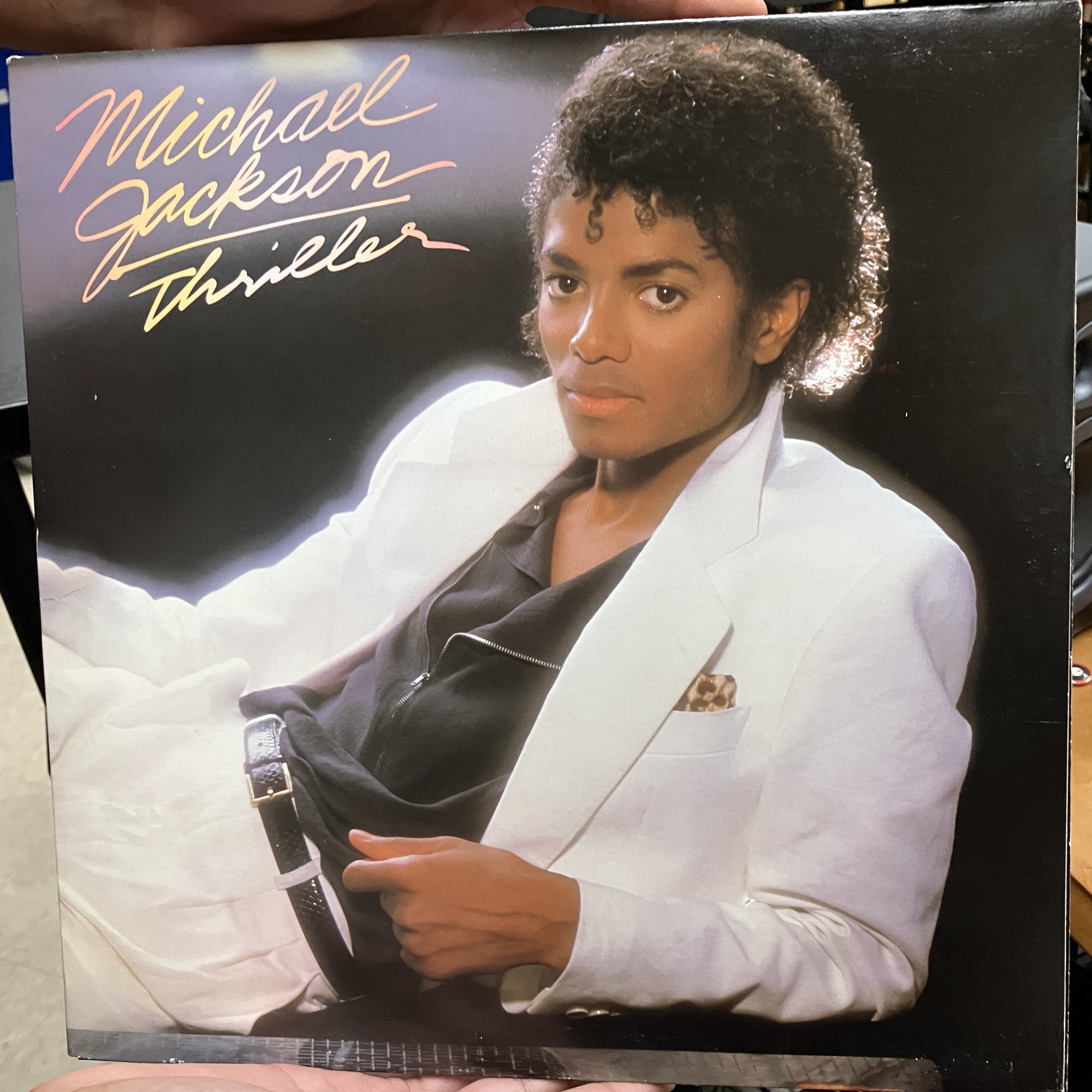
To be continued…

What’s Next
I’m extremely grateful that I stumbled upon Yale’s vinyl dungeon almost completely by chance. I’m looking forward to tapping into Yale’s classic rock collection throughout my research visit, listening to about an album per week. As I listen to new albums, I’ll keep this page updated with my thoughts and reflections. Let me know if you have any recommendations for what album I should listen to next week!5 I’m open both to listening to the classics and discovering new albums on vinyl.
-
The next few albums I searched for turned up nothing. My next searches were The Wall - Pink Floyd, Rumours - Fleetwood Mac, Black Album - Metallica, A Night at the Opera - Queen. Honestly, I was pretty lucky that Yale actually had the first album I searched up, otherwise I probably would have just given up 😅 ↩
-
For Yale students reading this who want to access Yale’s historical sound recordings in the future, skip all these steps and just send Mark an email! ↩
-
Update: In Mark’s words, “In the Beatles era, if something or someone was ‘heavy,’ it meant they were serious, significant, and sometimes hard to grasp.” Makes sense to me! ↩
-
I looked it up after, and it turns out this wasn’t Italian after all, but instead just some nonsense mishmash mix of languages – even more absurd! ↩
-
You can search Yale’s audio catalog here and find vinyl records by clicking into the album and ensuring the format is analog (33 1/3 rpm). ↩